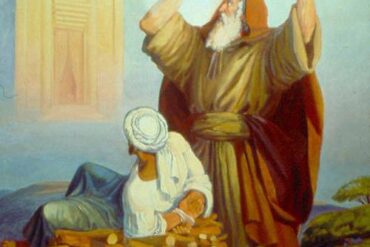Rosh Ḥodesh Adar marks the beginning of the twelfth month on the Hebrew calendar according to the Torah’s counting. The fact that Adar sees none of the same fanfare as the month of Elul, which marks the end of the year as we count it from Tishrei, raises many questions regarding the significance of this month, and its relation to the Nisan, the first month that Israel marked as a nation.
At its root, Adar is a time of material and experienced salvation (yeshua), in contrast to the exceptionally spiritual and miraculous nature of Nisan’s redemption (geula). Most explicitly, the festival of Purim celebrates our salvation from the evil Haman’s plot to destroy all the Jews of the Persian Empire, a salvation affected by the political maneuvering of Mordekhai and Esther, rather than open miracles from HaShem.
In fact, the tradition of dressing up on Purim derives from the hidden nature of HaShem’s salvation, and the fact that He operated in the Purim story through human agents rather than intervening to change the natural order of the world.
However, this aspect of Adar goes far beyond the Purim story. Its roots can be found in the Book of Sh’mot while the Hebrews were still enslaved in Egypt.
First, we learn from our Sages that our teacher Moshe was born on the 7th of Adar. Immediately following his birth, he was hidden, first in a cupboard and then in a basket of reeds, because in order to be the earthly catalyst for Divine redemption, he first needed to be hidden from the Egyptian authorities who sought to kill all newborn Hebrew boys.
Years later, during the famous plagues on Egypt, Adar again held great significance. According to our Sages, each plague occurred a month after the previous plague, with three weeks of warning or waiting and a single week of the plague.
According to this, the three days of the plague of darkness would have occurred right around the middle of Adar, the same dates as our salvation in the Purim story. From here, we can see that Adar is a month of darkness, of hiddenness, and of secrecy, when HaShem actively advances our salvation, but through less revealed channels.
This same dynamic is evident in the Tannaitic period, when Megillat Ta’anit recorded multiple instances of national salvation during this month.
On the 12 of Adar, our ancestors celebrated “Trajan’s Day” in commemoration of Roman Emperor Trajan’s (apocryphal) dethroning and execution during the Diaspora Revolt (Kitos War), following his execution of two of our revolutionary leaders.
On the 13th of Adar, Israel celebrated “Nikanor Day” in commemoration of Yehuda Maccabi’s triumph over the Seleucid-Greek General Nikanor, who had threatened the destruction of Jerusalem.
On the 17th of the month, during the reign of Alexander Yanai, the sages of Tzipori (who had fled from the king) were saved from the evil machinations of the nations to whom they fled by escaping at night through a clever ruse. It is clear that through the Persian, Hellenistic, and Roman periods, the Jews saw Adar as a special period for salvation, not through miracles, but through common political machinations and natural phenomena.
This view of the month of Adar was revived over a millennium later through the tradition of Purim Katan. Individual communities throughout the Jewish world would mark the dates of their salvation from various anti-Jewish rulers or cruel government policies through a day of feasting, and many would even write scrolls telling the stories of their tribulations and salvations in our people’s historiographical style.
Many such celebrations fell specifically in the month of Adar. The Jews of Narbonne celebrated their salvation from Christian rioters in 4996 (1236) on the 21st of Adar, the Jews of Cairo celebrated their salvation from the Egyptian Mamluk Governor’s arrests and extortions in 5284 (1524) on the 28th, the Jews of Frankfurt celebrated their salvation from expulsion by anti-semitic guild leaders in 5374 (1614) on the 20th, and the Jews of Rhodes celebrated their salvation from torture and executions around blood libel charges in 5600 (1840) on the 14th.
While it is unclear exactly when this tradition was revived, the diverse application in distant times and places of the Jewish Diaspora is a testament to the deeply ingrained connection between Jewish salvation and Adar, even at times when HaShem’s imminence in the world is hard to see.
The Tosfot Yom Tov even established a familial Purim Katan on Rosh Ḥodesh Adar in commemoration of his release from prison.
Even in our own times, we can see a hint of the saving potential of Adar. May we merit this year to experience all of the salvation that this month brings, not as the natural developments of political and economic happenstance but as the manifestation of HaShem’s will being realized through history.





